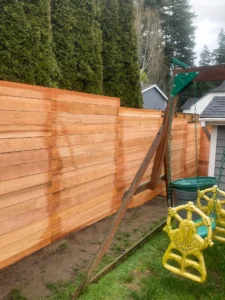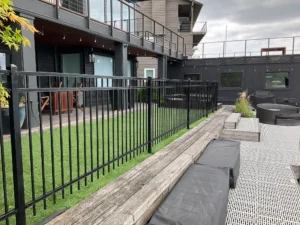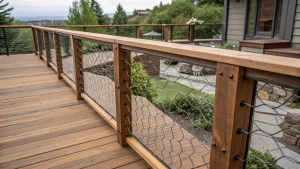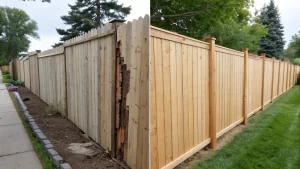Weather-resistant fencing showdown: vinyl vs composite durability comparison with expert insights from Inline Fence installation specialists. 👷👷
When you live in the Seattle area, you get used to the rain — but your fence might not. Constant moisture, moss growth, and soggy soil can be tough on outdoor structures. That’s why choosing the best fence material for wet weather isn’t just about looks — it’s about protecting your investment.
Two of the most popular choices for homeowners looking for a long-lasting, low-maintenance solution are vinyl and composite fencing. Both promise durability and come in many styles to complement your outdoor space, but they perform differently when faced with months of drizzle, strong winds, and occasional extreme cold.
In this guide, we’ll break down vinyl vs composite fence options, explore the key differences, compare their durability, lifespan, and maintenance needs, and give you a clear idea of which material performs best in the Pacific Northwest’s rainy climate. By the end, you’ll know which one offers superior durability and minimal maintenance — and if you need a trusted local fence installer, Inline Fence is here to make the process easy with expert advice, professional installation, and a commitment to customer satisfaction.
Understanding fence materials for wet weather conditions
In Seattle’s climate, constant rain means fence materials must fight moisture damage year-round. Here’s what really matters when choosing a fence that will last.
What makes the best fence material for rainy climates
Rain doesn’t just make things wet — it changes how materials age. Wood can swell, split, and rot when it absorbs too much water. Composite fences may resist rot, but most composite fences have recycled wood fibers that can soak up moisture over time, leading to mold stains, fading, and warping. Vinyl, made from pvc materials, is 100% non-porous and will not absorb water. It keeps its shape even in extreme temperatures or high heat, which is a significant factor in ensuring a warp long life for your fence. That makes vinyl one of the best fence materials for homeowners who want a fence that looks as good on day 1,000 as it did on day one.
Different types of fences and their weather challenges
Every material has its weakness in wet weather. Wood needs constant sealing or staining to preserve its natural beauty and avoid rot. Metal fences can rust or develop sharp edges as coatings wear away. Composite fencing is an eco friendly option, but because of its recycled wood content, it can still absorb water, leading to algae growth without proper care. Vinyl avoids these issues entirely, holding color, staying straight, and giving an aesthetically pleasing look with only occasional cleaning required.
Ready for a fence that can handle Seattle's rain? 👉 Contact Inline Fence today for a free quote.
Composite fence vs vinyl: material breakdown
Both materials claim to be weather-resistant, but their manufacturing process and composition tell a different story.
Vinyl fencing vs composite construction and durability
Vinyl fencing is made entirely from polyvinyl chloride (PVC), a material that doesn’t absorb water and resists mold, mildew, and insect damage. This makes it ideal for the damp soil and frequent rain of the Pacific Northwest. Its smooth surface doesn’t hold moisture, which helps prevent moss buildup and makes cleaning easy — usually just a quick spray with a garden hose. Vinyl’s flexibility also helps it withstand wind without cracking.
Composite fences, on the other hand, are a blend of wood fibers and plastic. While this gives them a natural wood-like look, it also introduces a weakness: those wood fibers can wick in moisture over time, especially if the fence is scratched or improperly sealed. Once moisture gets inside, the boards can swell or stain, and mold growth may become an ongoing maintenance battle.
Composite fence advantages in moisture-heavy environments
Composite fences are made from a mix of recycled plastic and wood fibers, giving them a look that’s closer to natural wood than vinyl. One of their key advantages is their strength — composite panels are typically thicker and heavier than vinyl, which can make them feel more solid. They don’t need to be stained or painted like wooden cedar fences, and they’re less likely to splinter or warp compared to untreated wood. Many homeowners also like that composite materials come in a wide range of colors and wood-grain textures, allowing them to match the style of their home.
That said, composite is not completely maintenance-free. Because composite fences contain wood fibers, they can still absorb moisture over time, which may lead to fungal growth or decay if water penetrates the matrix. Studies by the USDA Forest Products Laboratory show that wood-plastic composites exposed to wet conditions gradually develop microcracks that permit moisture intrusion and fungal attack. In consistently wet climates like Seattle’s, this means composite fences may require more frequent cleaning and upkeep than homeowners expect.
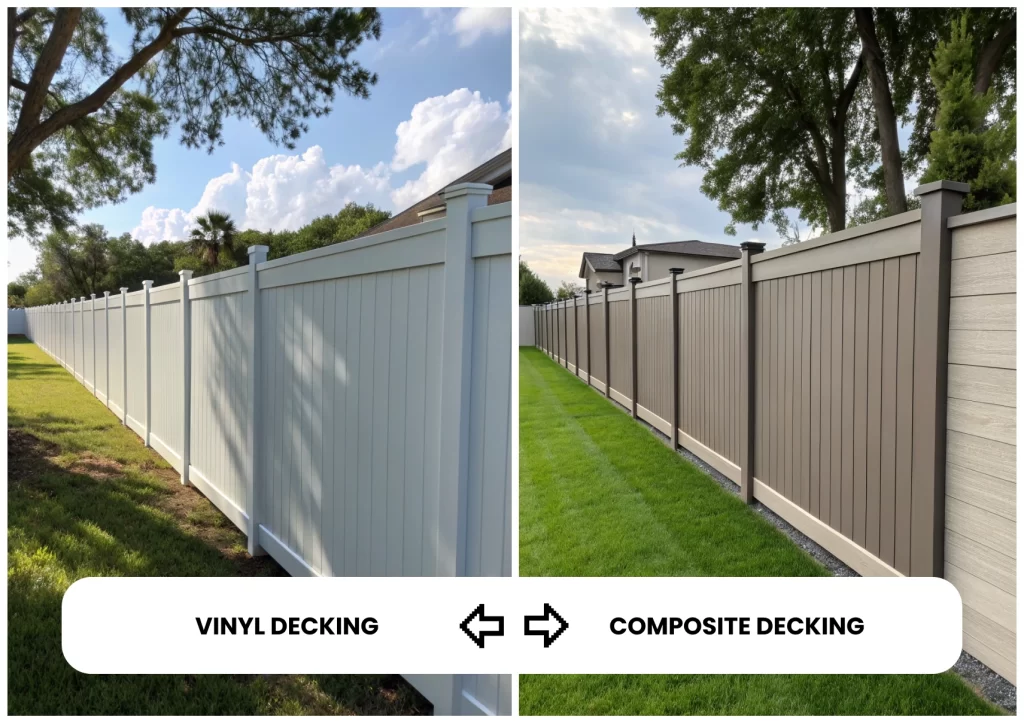
How long do vinyl fences last vs composite longevity
Fence longevity is one of the most important factors for homeowners in the Pacific Northwest. Constant moisture, freeze-thaw cycles, and soil movement can shorten the life of a poorly chosen fence. Here’s how vinyl and composite compare over time.
Vinyl fence life expectancy in rainy climates
One of vinyl’s biggest strengths is its impressive lifespan. A well-installed vinyl fence can last 20 to 30 years or more — even in wet conditions like those found in Seattle. For example, a review of vinyl fencing confirms its strong durability, resistance to rot and moisture, especially compared to traditional wood. Because vinyl doesn’t absorb moisture, it won’t rot, blister, or peel the way wood can. Its UV-resistant surface helps prevent fading, so it keeps its original color without the need for repainting or staining.
Another advantage is structural stability: vinyl fence posts and panels don’t warp or crack when saturated with rainwater. That means your fence stays straight and secure year after year with minimal upkeep. For homeowners looking for predictable, long-term performance, vinyl fence life expectancy is hard to beat.
Composite fencing lifespan and weather resistance
Composite fences also offer better longevity than untreated wood, often lasting 15 to 25 years, depending on the quality of the product and installation. However, their partial wood content means they can still experience swelling, fading, and mold growth when exposed to constant rain. In climates with heavy moisture, these issues may shorten the fence’s lifespan or require extra cleaning to maintain its appearance.
While composite remains a strong option compared to wood, homeowners in consistently wet climates often find that vinyl delivers a more durable, lower-maintenance solution over the long haul.
Your low-maintenance, rain-proof fence is just a call away 👉 Schedule with Inline Fence now.
Low maintenance fence options for wet climates
Seattle homeowners know that a fence that constantly needs cleaning or repairs isn’t worth the hassle. Here’s how vinyl and composite compare when it comes to upkeep.
Fence maintenance free solutions: vinyl advantages
Vinyl is as close as you can get to a low maintenance fence. Because it’s completely waterproof, it doesn’t need sealing, staining, or painting — ever. A quick rinse with a garden hose or light soap-and-water wash is usually enough to remove dirt, pollen, and the occasional moss. Even after years of rain, vinyl won’t rot, peel, or attract termites, making it ideal for homeowners who want a true fence maintenance free solution.
Another benefit is that vinyl panels don’t splinter or rust, which keeps them looking neat without sanding or refinishing. This simple care routine makes vinyl especially popular for busy families and rental properties where regular upkeep can be difficult.
Best low maintenance fence material comparison
Composite fencing is often advertised as no maintenance fencing, but that’s not completely accurate — especially in a rainy climate. Its wood fibers can develop mold spots or algae, meaning you may need to scrub or pressure wash sections of the fence to keep it looking fresh. Over time, composite boards may also experience some fading, which can be corrected with special cleaners or refinishing products.
While composite is easier to maintain than natural wood, vinyl typically requires less frequent and less intensive cleaning, making it the best low maintenance fence material for the Pacific Northwest.
Cost analysis: vinyl vs composite fence pricing
Price matters — but so does value over time. Here’s how vinyl and composite compare in both upfront and long-term costs.
Upfront investment and long-term value
Vinyl fences are usually more affordable upfront than composite, especially when you factor in installation. Composite materials are denser and heavier, which can make installation more labor-intensive and expensive. Once installed, vinyl rarely needs major repairs or refinishing, helping homeowners save money over decades of use.
If you’re thinking about resale value, a well-maintained vinyl fence adds curb appeal and shows buyers that the property is low-maintenance — a selling point in the competitive Seattle market. This combination of lower initial cost and reduced upkeep makes vinyl a smart, cost-effective choice for many homeowners.
Weather-related maintenance costs over time
Composite fences can develop surface mold, algae, or fading, which may require power washing, special cleaners, or even board replacement over time. These small but regular costs can add up, especially in a climate where rain is nearly constant for months at a time.
Vinyl’s resistance to water damage means fewer repairs, fewer replacements, and a maintenance-free privacy fence experience for years. Over its lifespan, vinyl often proves to be the most durable low-maintenance fence — not just in performance but in cost savings.
⭐⭐⭐⭐⭐
“I had Inline installed a vinyl and chain link fence around the yard, I felt that they showed great expertise and offered me many suggestions on how to choose what type of fence, pricing, gate placement, etc. they came out 3 times to double-check measurements which I greatly appreciated. The fence looks great! And it was completed in about 5 hours!! I would certainly choose them again.”– Andrea M.
Real-world performance: vinyl fence vs wood fence context
Traditional wood fences have a classic look, but in Seattle’s rainy climate, they require constant upkeep to stay standing and looking good. Here’s how vinyl and composite stack up against wood in real-world conditions.
Wood fences are vulnerable to rot, mold, and insect damage when exposed to months of moisture. Even pressure-treated cedar or pine needs staining or sealing every 1–2 years to stay protected — a time-consuming and costly commitment. In soft, rain-soaked soil, wooden posts can lean or shift over time, meaning repairs are almost inevitable.
Vinyl eliminates these problems entirely. Because it doesn’t absorb water, it won’t swell, warp, or split, and it doesn’t need paint or sealant to stay looking new. Composite fencing is also more weather-resistant than wood, but its partial wood content means it can still develop surface mold or discoloration.
For homeowners who want a fence that can handle Seattle’s rain without turning into a weekend project, vinyl fencing vs wood fence isn’t even a contest — vinyl is the clear winner for durability, stability, and low maintenance.
Making the right choice for your rainy climate property
Traditional wood fences have a classic look, but in Seattle’s rainy climate, they require constant upkeep to stay standing and looking good. Here’s how vinyl and composite stack up against wood in real-world conditions.
Wood fences are vulnerable to rot, mold, and insect damage when exposed to months of moisture. Even pressure-treated cedar or pine needs staining or sealing every 1–2 years to stay protected — a time-consuming and costly commitment. In soft, rain-soaked soil, wooden posts can lean or shift over time, meaning repairs are almost inevitable.
Vinyl eliminates these problems entirely. Because it doesn’t absorb water, it won’t swell, warp, or split, and it doesn’t need paint or sealant to stay looking new. Composite fencing is also more weather-resistant than wood, but its partial wood content means it can still develop surface mold or discoloration.
For homeowners who want a fence that can handle Seattle’s rain without turning into a weekend project, vinyl fencing vs wood fence isn’t even a contest — vinyl is the clear winner for durability, stability, and low maintenance.
Making the right choice for your rainy climate property
Choosing the right fence is a significant factor for curb appeal and property value. Vinyl delivers unique benefits like superior durability, minimal maintenance, and the ability to withstand harsh weather conditions while staying aesthetically pleasing. Composite fencing is an improvement over wood, but its partial wood content makes it more vulnerable to mold, fading, and warping when exposed to the Pacific Northwest’s year-round dampness.
The table below summarizes the essential points, guiding you through the choice between vinyl and composite fencing.
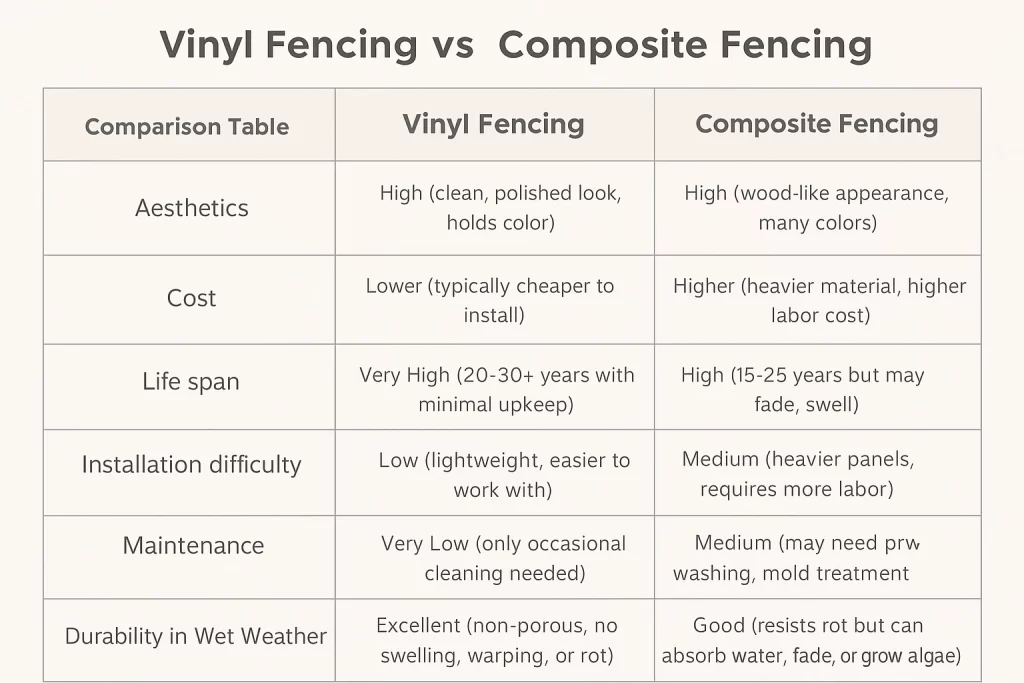
If you’re ready for a fence that will look great for decades with only occasional cleaning, Inline Fence is your trusted local fence installer in the Seattle area. We specialize in vinyl fence installation and offer free estimates to get your project started quickly.


